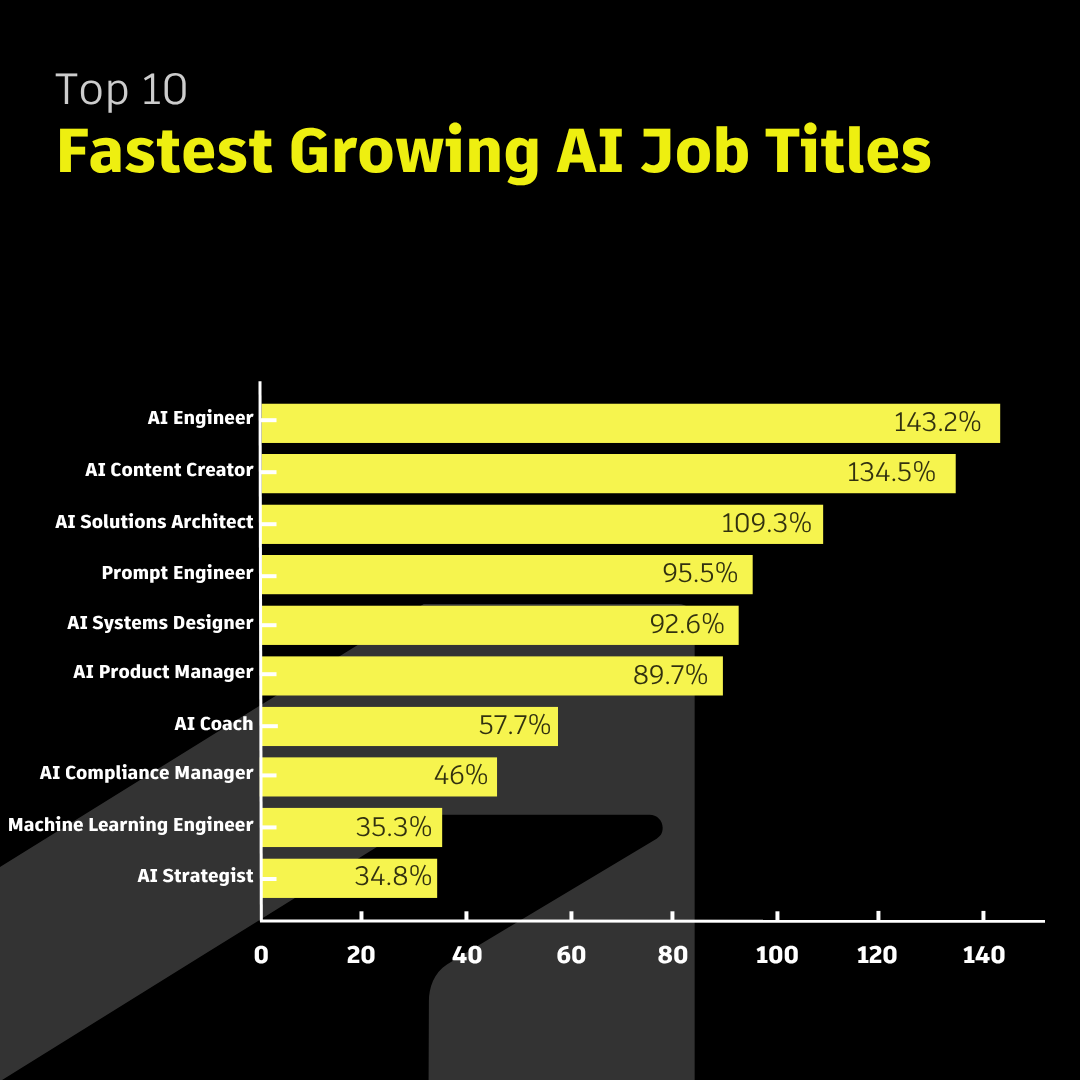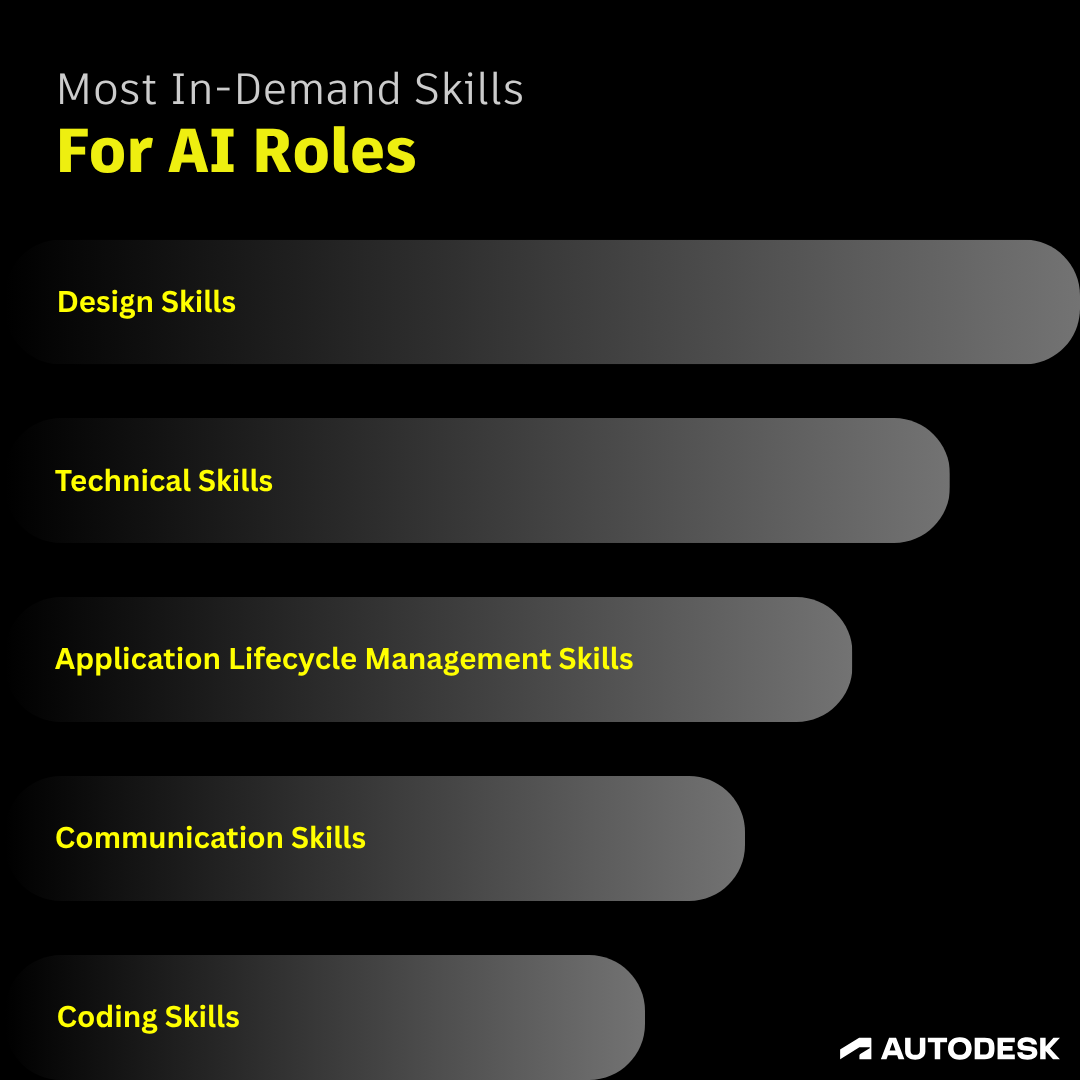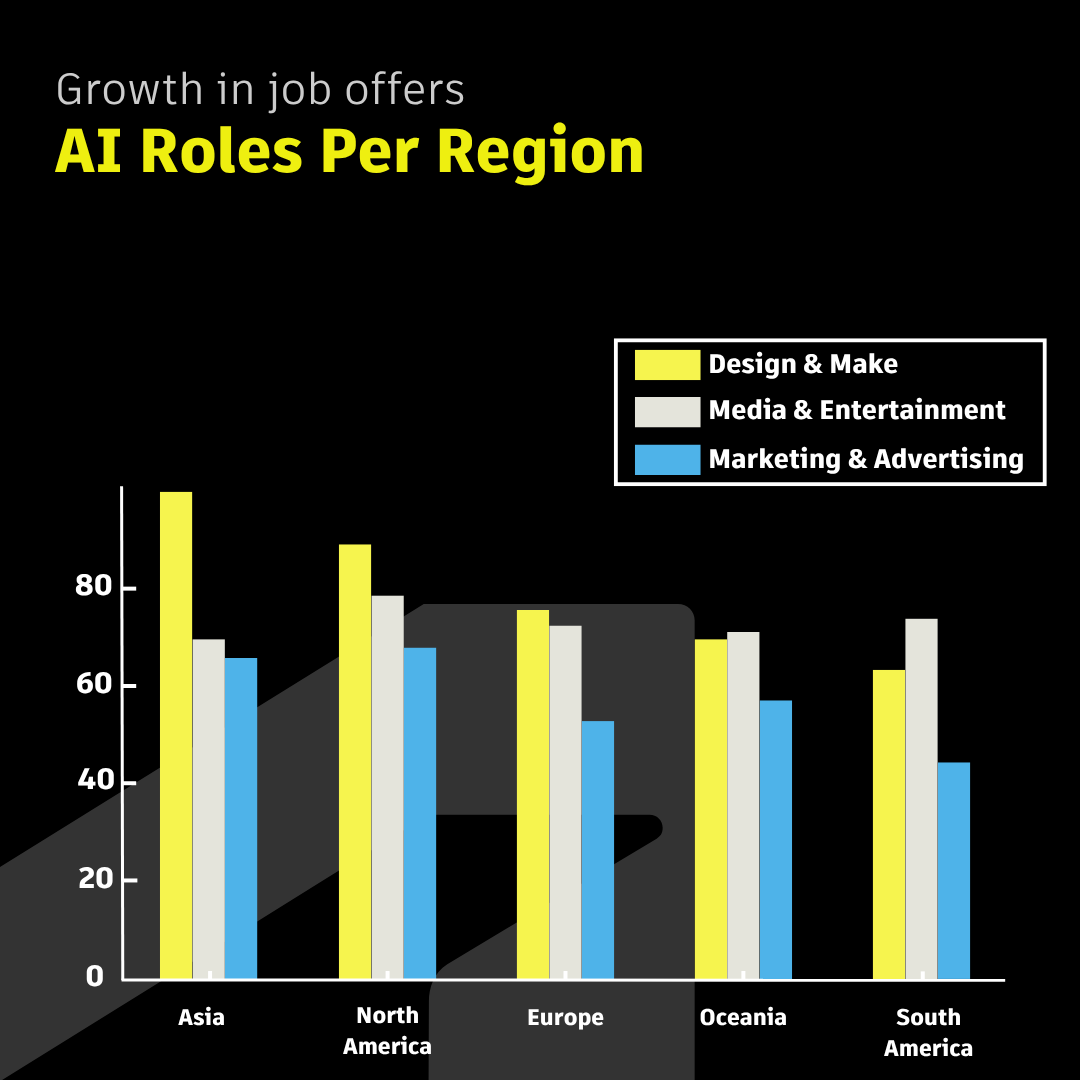- AI fluency is no longer optional across various Design and Make roles. Mentions of AI in US job listings have surged by 56.1% in 2025 (through April), building on explosive growth in 2023 (+114.8%) and 2024 (+120.6%). What was once a niche skillset is now a core qualification, reshaping hiring across nearly every function—from engineering to marketing to operations.
- A new class of roles is emerging—and they’re not all technical. Positions like AI Engineer (+143.2%), Prompt Engineer (+135.8%), and AI Content Creator (+134.5%) are among the fastest growing this year. These roles reflect the rise of an AI-native workforce that blends technical fluency with creativity, communication, and applied insight.
- Human skills aren’t being replaced—they’re being revalued. In fact, design has overtaken technical expertise as the most in-demand skill in AI-related job postings. Also in the top 10: communication, collaboration, and leadership. As AI systems become more capable, companies are placing greater value on the human qualities that guide, scale, and govern them—judgment, empathy, and imagination.
Autodesk today released its first AI Jobs Report, offering a detailed look at how artificial intelligence is reshaping the workforce across Design and Make industries—including architecture, engineering, construction, product design, manufacturing, media, and entertainment. The findings show that AI-driven job growth remains strong in 2025, with emerging roles, new skill demands, and regional shifts redefining what it means to be ready for the future of work.
Autodesk’s AI Jobs Report makes one thing clear: the future of work isn’t waiting. It’s here and moving quickly. The winners in this AI-driven economy will be the ones who can merge tech fluency with human creativity, ethics, and leadership.
Conducted in partnership with research firm GlobalData, the report analyzed nearly 3 million job listings across a two-year period and identified four major workforce trends:
AI fluency is on track to become a baseline expectation across the workforce
- Mentions of AI in general job listings have skyrocketed: up 114.8% in 2023, up 120.6% in 2024, and up 56.1% year to date in 2025, signaling AI capabilities are no longer confined to technical or specialized roles.
- Fluency in AI is quickly becoming a core requirement for career longevity across industries.

AI is creating a new class of jobs—with both technical and non-technical AI roles growing in parallel
- From AI Coach to AI Strategist, entirely new roles are starting to gain traction across Design and Make, reflecting growing demand for those who can translate, communicate, scale, and govern AI—not just build it.
- Roles in AI product, compliance, and enablement are also accelerating, further signaling the formation of a new, AI-native job class.
- The data also shows that technical and non-technical AI roles are growing at similar rates. Listings for AI Engineer (+143.2%) and AI Solutions Architect (+109.3%) surged year over year—tracking closely with non-technical roles like AI Content Creator (+134.5%).
- The top 10 fastest growing AI titles in Design and Make industries:
- AI Engineer: +143.2%
- AI Content Creator: +134.5%
- AI Solutions Architect: +109.3%
- Prompt Engineer: +95.5%
- AI Systems Designer: +92.6%
- AI Product Manager: +89.7%
- AI Coach: +57.7%
- AI Compliance Manager: +46.0%
- Machine Learning Engineer: +35.3%
- AI Strategist: +34.8%

Demand for human-centered skills in AI roles is increasing
- In 2025, design skills have surpassed coding, cloud, and other technical competencies to become the most in-demand skill in AI-specific job listings—underscoring the growing importance of human-centered thinking in how AI is built and applied.
- Communication, leadership, people, and collaboration skills also land in the top 10, signaling that interpersonal fluency and the ability to lead teams remain essential in AI-driven roles.
- The top 10 most in-demand skills for AI roles in Design and Make industries:
- Design skills
- Technical skills
- Application Lifecycle Management skills
- Communication skills
- Coding skills
- People skills
- Leadership skills
- Analytical skills
- Collaboration skills
- Cloud service skills

Companies hiring for AI roles are looking for more than technical expertise—they’re seeking talent that can bring human ingenuity and strategic judgment to the work. As AI jobs grow, so does the demand for the uniquely human skills that make AI effective.
AI hiring by region
Autodesk’s report looked at the percent change in AI job listings year over year and found that Asia has surged ahead in AI hiring, with job listings growing 94.2% year over year—outpacing North America (+88.9%) and highlighting a widening global divide.
While Asia and North America are leading AI hiring growth, South America lags at 63.4%, raising questions about global AI readiness and talent investment strategies.

For the full 2025 AI Jobs Report and press assets, visit the AI Jobs Report media kit.
Methodology
Autodesk’s AI Jobs Report was conducted in partnership with third-party analytics firm GlobalData and examined nearly 3 million job postings over a two-year period across Design and Make industries—including architecture, engineering, construction, product design, manufacturing, media, and entertainment.
GlobalData used its proprietary Job Analytics platform to track daily job postings from companies globally. It also used its advanced platform to analyze job postings on company career pages and other trusted sources. All data is anonymized and does not include private or individual recruiter listings.
About the results
The data spans three rolling 12-month periods measured from May to April: the 2023 cycle includes postings from May 2022 through April 2023, the 2024 cycle includes postings from May 2023 through April 2024 (1.289 million job listings), and the 2025 cycle includes postings from May 2024 through April 2025 (1.488 million job listings). These totals include both AI-related and general job listings.
“AI-related” roles are defined as those where artificial intelligence is a major component of the position or its primary function—beyond surface-level mentions or general familiarity. This includes roles explicitly centered around AI use, implementation, oversight, and application.